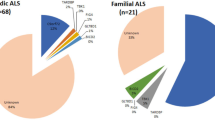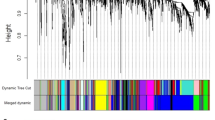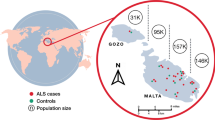Abstract
We aimed to identify the genetic cause of the devastating neurodegenerative disease amyotrophic lateral sclerosis (ALS) in a German family with two affected individuals, and to assess the prevalence of variants in the identified risk gene, FIG4, in a central European ALS cohort. Whole-exome sequencing (WES) and an overlapping data analysis strategy were performed in an ALS family with autosomal dominant inheritance and incomplete penetrance. Additionally, 200 central European ALS patients were analyzed using whole-exome or targeted sequencing. All patients were subjected to clinical, electrophysiological, and neuroradiological characterization to explore genotype–phenotype relationships. WES analysis of the ALS family identified the rare heterozygous frameshift variant FIG4:c.759delG, p.(F254Sfs*8) predicted to delete the catalytic domain and active center from the encoded phosphoinositide 5-phosphatase with a key role in endosomal vesicle trafficking. Additionally, novel or rare heterozygous FIG4 missense variants predicted to be deleterious were detected in five sporadic ALS patients revealing an overall FIG4 variant frequency of 3% in our cohort. Four of six variants identified were previously associated with ALS or the motor and sensory neuropathy Charcot-Marie-Tooth disease type 4J (CMT4J), whereas two variants were novel. In FIG4 variant carriers, disease duration was longer and upper motor neuron predominance was significantly more frequent compared with ALS patients without FIG4 variants. Our study provides evidence for FIG4 as an ALS risk gene in a central European cohort, adds new variants to the mutational spectrum, links ALS to CMT4J on a genetic level, and describes a distinctive ALS phenotype for FIG4 variant carriers.
Similar content being viewed by others
Log in or create a free account to read this content
Gain free access to this article, as well as selected content from this journal and more on nature.com
or
References
Robberecht W, Philips T : The changing scene of amyotrophic lateral sclerosis. Nat Rev Neurosci 2013; 14: 248–264.
Bäumer D, Talbot K, Turner MR : Advances in motor neurone disease. J R Soc Med 2014; 107: 14–21.
Byrne S, Walsh C, Lynch C et al: Rate of familial amyotrophic lateral sclerosis: a systematic review and meta-analysis. J Neurol Neurosurg Psychiatry 2011; 82: 623–627.
Turner MR, Hardiman O, Benatar M et al: Controversies and priorities in amyotrophic lateral sclerosis. Lancet Neurol 2013; 12: 310–322.
Li HF, Wu ZY : Genotype–phenotype correlations of amyotrophic lateral sclerosis. Transl Neurodegener 2016; 5: 3.
Chow CY, Landers JE, Bergren SK et al: Deleterious variants of FIG4, a phosphoinositide phosphatase, in patients with ALS. Am J Hum Genet 2009; 84: 85–88.
Rutherford AC, Traer C, Wassmer T et al: The mammalian phosphatidylinositol 3-phosphate 5-kinase (PIKfyve) regulates endosome-to-TGN retrograde transport. J Cell Sci 2006; 119: 3944–3957.
Sbrissa D, Ikonomov OC, Fu Z et al: Core protein machinery for mammalian phosphatidylinositol 3,5-bisphosphate synthesis and turnover that regulates the progression of endosomal transport. Novel Sac phosphatase joins the ArPIKfyve-PIKfyve complex. J Biol Chem 2007; 282: 23878–23891.
Chow CY, Zhang Y, Dowling JJ et al: Mutation of FIG4 causes neurodegeneration in the pale tremor mouse and patients with CMT4J. Nature 2007; 448: 68–72.
Campeau PM, Lenk GM, Lu JT et al: Yunis-Varón syndrome is caused by mutations in FIG4, encoding a phosphoinositide phosphatase. Am J Hum Genet 2013; 92: 781–791.
Baulac S, Lenk GM, Dufresnois B et al: Role of the phosphoinositide phosphatase FIG4 gene in familial epilepsy with polymicrogyria. Neurology 2014; 82: 1068–1075.
Körner S, Kollewe K, Fahlbusch M et al: Onset and spreading patterns of upper and lower motor neuron symptoms in amyotrophic lateral sclerosis. Muscle Nerve 2011; 43: 636–642.
Classen CF, Riehmer V, Landwehr C et al: Dissecting the genotype in syndromic intellectual disability using whole exome sequencing in addition to genome-wide copy number analysis. Hum Genet 2013; 132: 825–841.
Abel O, Powell JF, Andersen PM, Al-Chalabi A : ALSoD: a user-friendly online bioinformatics tool for amyotrophic lateral sclerosis genetics. Hum Mutat 2012; 33: 1345–1351.
Lulé D, Burkhardt C, Abdulla S et al: The Edinburgh Cognitive and Behavioural Amyotrophic Lateral Sclerosis Screen: a cross-sectional comparison of established screening tools in a German-Swiss population. Amyotroph Lateral Scler Frontotemporal Degener 2015; 16: 16–23.
Nicholson G, Lenk GM, Reddel SW et al: Distinctive genetic and clinical features of CMT4J: a severe neuropathy caused by mutations in the PI(3,5)P2 phosphatase FIG4. Brain 2011; 134: 1959–1971.
Tsai CP, Soong BW, Lin KP, Tu PH, Lin JL, Lee YC : FUS, TARDBP, and SOD1 mutations in a Taiwanese cohort with familial ALS. Neurobiol Aging 2011; 32: 553e13–553e21.
Verdiani S, Origone P, Geroldi A et al: The FIG4 gene does not play a major role in causing ALS in Italian patients. Amyotroph Lateral Scler Frontotemporal Degener 2013; 14: 228–229.
Cady J, Allred P, Bali T et al: Amyotrophic lateral sclerosis onset is influenced by the burden of rare variants in known amyotrophic lateral sclerosis genes. Ann Neurol 2015; 77: 100–113.
Manford A, Xia T, Saxena AK et al: Crystal structure of the yeast Sac1: implications for its phosphoinositide phosphatase function. EMBO J 2010; 29: 1489–1498.
Lenk GM, Ferguson CJ, Chow CY et al: Pathogenic mechanism of the FIG4 mutation responsible for Charcot-Marie-Tooth disease CMT4J. PLoS Genet 2011; 7: e1002104.
Cirulli ET, Lasseigne BN, Petrovski S et al: Exome sequencing in amyotrophic lateral sclerosis identifies risk genes and pathways. Science 2015; 347: 1436–1441.
Van Blitterswijk M, van Es MA, Hennekam EA et al: Evidence for an oligogenic basis of amyotrophic lateral sclerosis. Hum Mol Genet 2012; 21: 3776–3784.
Strickland AV, Schabhüttl M, Offenbacher H et al: Mutation screen reveals novel variants and expands the phenotypes associated with DYNC1H1. J Neurol 2015; 262: 2124–2134.
DiVincenzo C, Elzinga CD, Medeiros AC et al: The allelic spectrum of Charcot-Marie-Tooth disease in over 17,000 individuals with neuropathy. Mol Genet Genomic Med 2014; 2: 522–529.
Chiò A, Pagani M, Agosta F, Calvo A, Cistaro A, Filippi M : Neuroimaging in amyotrophic lateral sclerosis: insights into structural and functional changes. Lancet Neurol 2014; 13: 1228–1240.
Swinnen B, Robberecht W : The phenotypic variability of amyotrophic lateral sclerosis. Nat Rev Neurol 2014; 10: 661–670.
Statland JM, Barohn RJ, Dimachkie MM, Floeter MK, Mitsumoto H : Primary lateral sclerosis. Neurol Clin 2015; 33: 749–760.
Ludolph A, Drory V, Hardiman O et al: A revision of the El Escorial criteria—2015. Amyotroph Lateral Scler Frontotemporal Degener 2015; 16: 291–292.
Pringle CE, Hudson AJ, Munoz DG, Kiernan JA, Brown WF, Ebers GC : Primary lateral sclerosis. Clinical features, neuropathology and diagnostic criteria. Brain 1992; 115: 495–520.
Huisman MH, de Jong SW, van Doormaal PT et al: Population based epidemiology of amyotrophic lateral sclerosis using capture–recapture methodology. J Neurol Neurosurg Psychiatry 2011; 82: 1165–1170.
Sali A, Blundell TL : Comparative protein modelling by satisfaction of spatial restraints. J Mol Biol 1993; 234: 779–815.
Couthouis J, Raphael AR, Daneshjou R, Gitler AD : Targeted exon capture and sequencing in sporadic amyotrophic lateral sclerosis. PLoS Genet 2014; 10: e1004704.
Acknowledgements
We thank the patients and their families for participating in this study, and are indebted to Christopher Baum, Reinhard Dengler, and Brigitte Schlegelberger for generous support and helpful discussions. Isolde Rangnau received a scholarship from the Klin-StrucMed program of Hannover Medical School funded by the Else Kröner-Fresenius-Stiftung. Anne Kosfeld and Ruthild G Weber received research support from the Else Kröner-Fresenius-Stiftung (Grant No. 2014_A234). Alma Osmanovic, Susanne Petri, and Ruthild G Weber received research support from the Petermax-Müller-Stiftung.
Author information
Authors and Affiliations
Corresponding author
Ethics declarations
Competing interests
The authors declare no conflict of interest.
Additional information
Supplementary Information accompanies this paper on European Journal of Human Genetics website
Supplementary information
Rights and permissions
About this article
Cite this article
Osmanovic, A., Rangnau, I., Kosfeld, A. et al. FIG4 variants in central European patients with amyotrophic lateral sclerosis: a whole-exome and targeted sequencing study. Eur J Hum Genet 25, 324–331 (2017). https://doi.org/10.1038/ejhg.2016.186
Received:
Revised:
Accepted:
Published:
Issue date:
DOI: https://doi.org/10.1038/ejhg.2016.186
This article is cited by
-
A lipid metabolism related gene signature predicts postoperative recurrence in pancreatic cancer through multicenter cohort validation
Scientific Reports (2025)
-
Amyotrophic Lateral Sclerosis: Focus on Cytoplasmic Trafficking and Proteostasis
Molecular Neurobiology (2025)
-
Genetic epidemiology of amyotrophic lateral sclerosis in Cyprus: a population-based study
Scientific Reports (2024)
-
FIG4-associated disease manifesting as rapidly progressive amyotrophic lateral sclerosis
Neurological Sciences (2024)
-
Clinical and genetic features of patients suffering from CMT4J
Journal of Neurology (2024)



